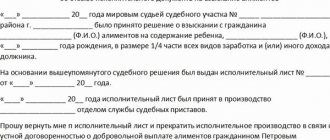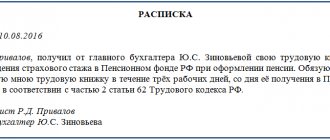Grounds for revocation
A writ of execution is a document issued by the court and transferred to the bailiff service (FSSP). It contains information about the participants in the process, the amount of debt (for example, debt to a creditor or alimony), the date of the decision and its entry into legal force.
The claimant has the right to initiate a suspension of the process by submitting an application for withdrawal of the IL. This happens most often due to the conclusion of a voluntary agreement on debt payment. Regulatory documents governing the recall procedure:
- Federal Law No. 229-FZ “On Enforcement Proceedings”.
- Article 327 of the Arbitration Procedure Code of the Russian Federation “Suspension, renewal and termination of enforcement proceedings” (for arbitration cases).
- Section VII of the Code of Civil Procedure of the Russian Federation “Proceedings related to the execution of court decisions and decisions of other bodies.”
It is important to distinguish between the withdrawal of a sheet at the initiative of the claimant and the suspension or termination of proceedings. In the latter case, the reason for returning the writ of execution may be the debtor’s incapacity, the inability to fulfill obligations for objective reasons (due to his conscription into the army, illness, arrest, bankruptcy of an LLC or individual entrepreneur, etc.).
In addition to the claimant’s appeal, revocation of the writ of execution may occur in the following cases:
- issuing a court ruling on the return of a sheet drawn up with errors or based on an insignificant act;
- an appeal from an arbitration manager who considers the claims of creditors within the framework of bankruptcy proceedings;
- cancellation of the notary's inscription on the contract.
After the issuance of a resolution on the fact of revocation, all prohibitions and restrictions regarding the debtor will be lifted. In particular, the property seizure is lifted and the seized items and items are returned.
Revocation of the writ of execution
Historical background
During the period of the late 15th-17th centuries. the bailiff was called a nedelschik because he performed his duties for weeks (“to be in weeks”). Week workers were attached to clerks, who entered their names in special books upon taking office. The duties of the weekly workers were to notify the parties about the summons and bring them to court, as well as to capture the criminals. All this was done by the week workers themselves only within the city. To be summoned to court from the districts, each week worker had with him seven so-called riders, who were also recorded in the clerks’ books. The riders acted on behalf of the week-long worker and under his responsibility.
Revocation of a writ of execution is an action that temporarily terminates enforcement proceedings. The collection process can be resumed in the future. The claimant will be able to re-submit the writ of execution for proceedings at any time if the deadline for its submission has not expired.
The law clearly provides for the time frame when the creditor will be able to re-apply for collection of obligations from the debtor. Article 21 of the Federal Law “On Enforcement Proceedings” regulates the deadlines for submitting a writ of execution for production. The validity period of the writ of execution is suspended at the time of production, when the writ of execution is withdrawn, the passage of time is not suspended.
Read more about the deadline for submitting a writ of execution in the article
According to Art. 46 of the Federal Law “On Enforcement Proceedings”, in order to revoke the writ of execution, the claimant will be able to contact the FSPP by writing a petition to revoke the writ of execution. It becomes an indisputable basis for the bailiff to make a decision to terminate enforcement proceedings. It is from this moment that the writ of execution is handed over to the claimant.
The revocation of a writ of execution by a claimant differs from the procedure for abandoning enforcement proceedings in that in the latter case it is not possible to resume enforcement proceedings.
The revocation of a writ of execution from the bailiff service sometimes has a negative impact on the debtor. After the claimant applies to the FSPP to resume enforcement proceedings, the collection procedure will be carried out again despite the fact that the circumstances that served as the basis for the revocation of the writ of execution remain.
One of the conditions for satisfying an application to revoke a writ of execution is the voluntary submission of such a document by the claimant. This means that its text should not contain any information about coercion to perform the specified action.
Enforcement proceedings always begin with the claimant filing a corresponding application or the court sending a writ of execution or the judicial act itself (court order) to the FSPP. The decision to revoke the writ of execution is made by the court. Only the claimant or his representative (if there is a power of attorney) initiates the process of enforcement of the court decision. In some cases, the writ of execution is revoked by the court.
Possible consequences
As soon as the application for revocation is accepted, considered and approved, the bailiff issues a resolution to terminate the case, and the writ of execution itself is returned to the claimant. But the debtor should not think that this procedure means complete release from debts. The claimant has the right to again submit a writ of execution with an application to resume proceedings by bailiffs.
Debtors may find themselves trapped due to the other party abusing their rights. Example: the participants in the case came to an oral agreement, a withdrawal of the IL was issued and the money for the debt was transferred from hand to hand. But the claimant decided to cheat and filed a petition for the bailiffs to resume the proceedings. To prevent such an incident from happening, you should not conduct business only in words. All agreements and the process of transferring debt must be confirmed by receipts, which should preferably be certified by a notary.
The list has been withdrawn, what next?
After the revocation, the claimant may once again present the writ of execution for execution. He has the right to do this within 3 years from the date of the FSSP Resolution to close the proceedings and repay the debt.
Moreover, if the debtor does not have his own property, then a new case on it can be reopened only after at least six months (Article 21, paragraph
2.1 Art. 30 of the Law of the Russian Federation No. 229-FZ).
However, the declared revocation entails certain risks for the claimant. So, it could be:
- Termination of debt payments after the conclusion of a settlement agreement. After execution of such a document, the debtor may refuse to transfer the remaining balance of the debt, which the parties to the agreement decided not to cancel.
- Debt payments become irregular or stop altogether. Although none of the parties planned to cancel it.
- It will be very difficult to collect the debt. After all, it will be difficult for the collector to collect significant evidence to collect debts from a citizen (organization).
As a result, in accordance with Russian legislation, the claimant has the right to revoke the writ of execution. Moreover, he can re-submit such a document to the bank (FSSP, Treasury of the Russian Federation) for execution within 3 years (if the debtor has no property - no earlier than six months later).
Related article: Where to apply for a writ of execution after trial
The writ of execution can be collected from the FSSP or from the bank. To do this, you must submit a correctly drafted petition to revoke an open writ of execution and attach the necessary documents to it. However, the claimant must also take into account the negative consequences that may arise in such a situation.
Procedure
According to Law No. 229-FZ, to initiate a revocation, a citizen must prepare an application in two copies and submit it to the FSPP unit that previously issued the resolution to initiate proceedings. No duties or fees are required from claimants.
If the IL was transferred to Sberbank or another financial institution, then it is recalled by an application submitted not to the FSSP, but to the bank itself. The same is done in cases where the sheet was given at the debtor’s place of work. If we are talking about the collection of budget funds, then the application is submitted to the Federal Treasury (UFK).
The writ of execution can be revoked throughout its entire validity period, regardless of the type of collection and the amount of the debt. The application submitted by the claimant is an unconditional basis for suspending the proceedings.
Within five days from the date of filing the appeal, the bailiffs prepare a resolution to terminate the proceedings. From this moment on, the defendant is released from paying the debt (until the collection procedure is resumed again at the request of the collector).
We withdraw the writ of execution. How is it going?
While the writ of execution is with the bailiffs, they must take measures to fulfill the requirements specified there. However, sometimes the claimant decides to revoke the sheet. Today we’ll look at the reasons for this decision, tell you how to submit an application and what will the revocation of the document lead to?
The creditor can be not only a bank or microfinance organization. Today, many citizens try to borrow money from their friends, acquaintances, that is, private individuals like themselves. And if a citizen cannot repay the loan on time without certificates and guarantors, then the creditor will have no choice but to go to court for the truth.
After the court decision is made, a writ of execution is formed, which, as a rule, is sent to the bailiffs. Based on this document, civil servants launch the process. If the creditor takes the document, the case will be closed instantly.
Sample application
The claimant submits an application to the FSSP, bank, place of work of the debtor or other institution in two copies. There is no official form for this document; it can be drawn up in free form. The main thing is to include the following information:
- in the header: name and address of the department where the application is submitted, full name and passport details of the applicant.
- in the center: information about the writ of execution (number and date of issue) and the basis on which the claimant revokes the IL.
- at the bottom: signature and date of the application, address of the plaintiff and debtor.
Sample review of a writ of execution:
Considering the many subtleties of all stages of revoking writs of execution, it is recommended to involve an experienced lawyer in the process. You will be provided with comprehensive assistance in preparing and submitting documents. This minimizes the risk of negative consequences, such as refusal to consider the application.
Application for revocation of a writ of execution
In order for the claimant to revoke the writ of execution, it is necessary to write a corresponding application. It is important that the text of the application does not contain information about coercion to revoke the specified document. The application must be drawn up in the name of the bailiff who opened the proceedings in the plaintiff’s case.
You can submit an application at any stage of enforcement proceedings. When it is reviewed by bailiffs, a positive decision is always made. In the event that the claimant does not have any grounds for revoking the enforcement document, he has the opportunity to write a statement that the enforcement proceedings be suspended. A sample of revoking a writ of execution from bailiffs can be found on our website.
Sample revocation of a writ of execution from bailiffs
If you have questions about revoking the writ of execution, leave them in the comments









